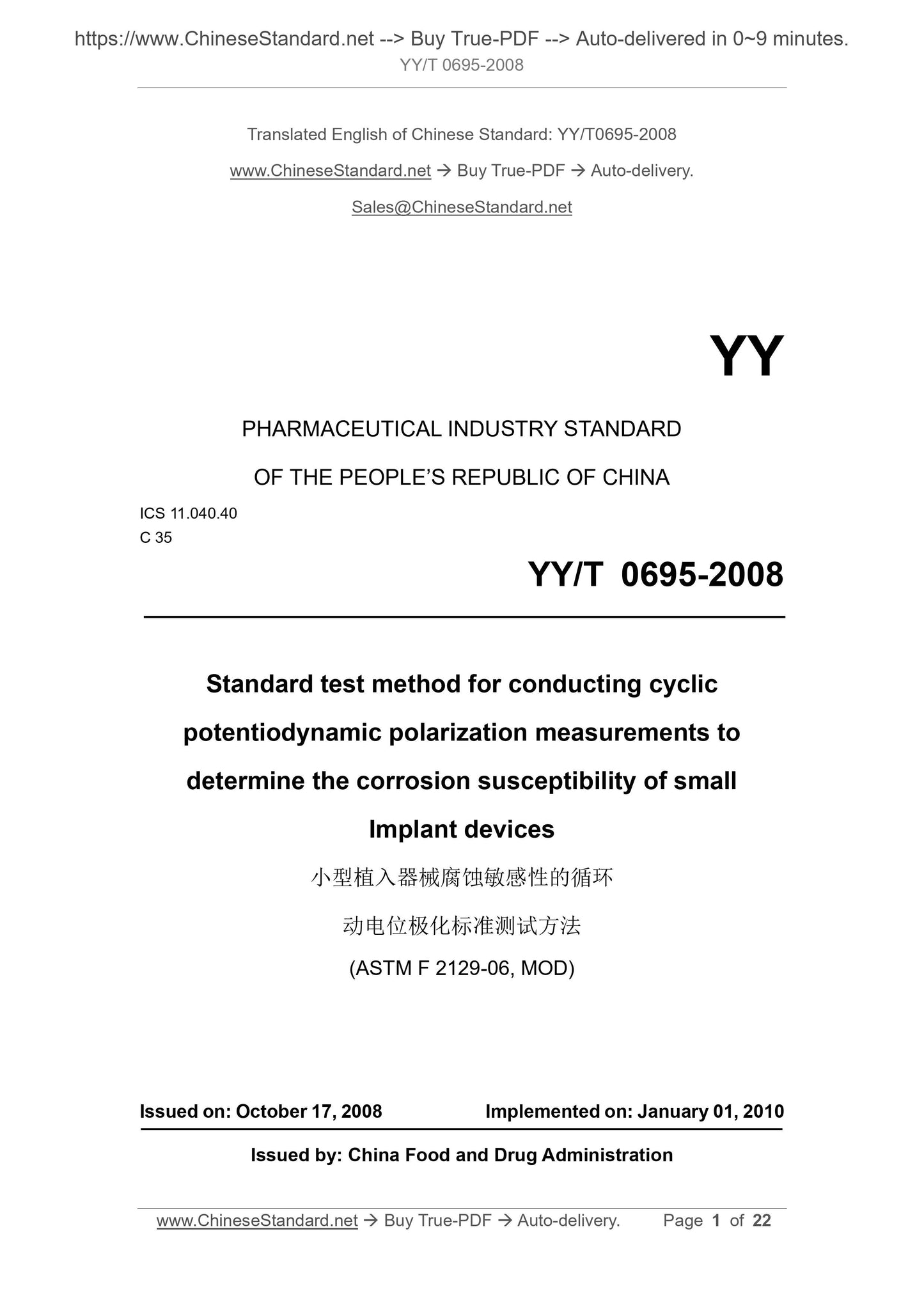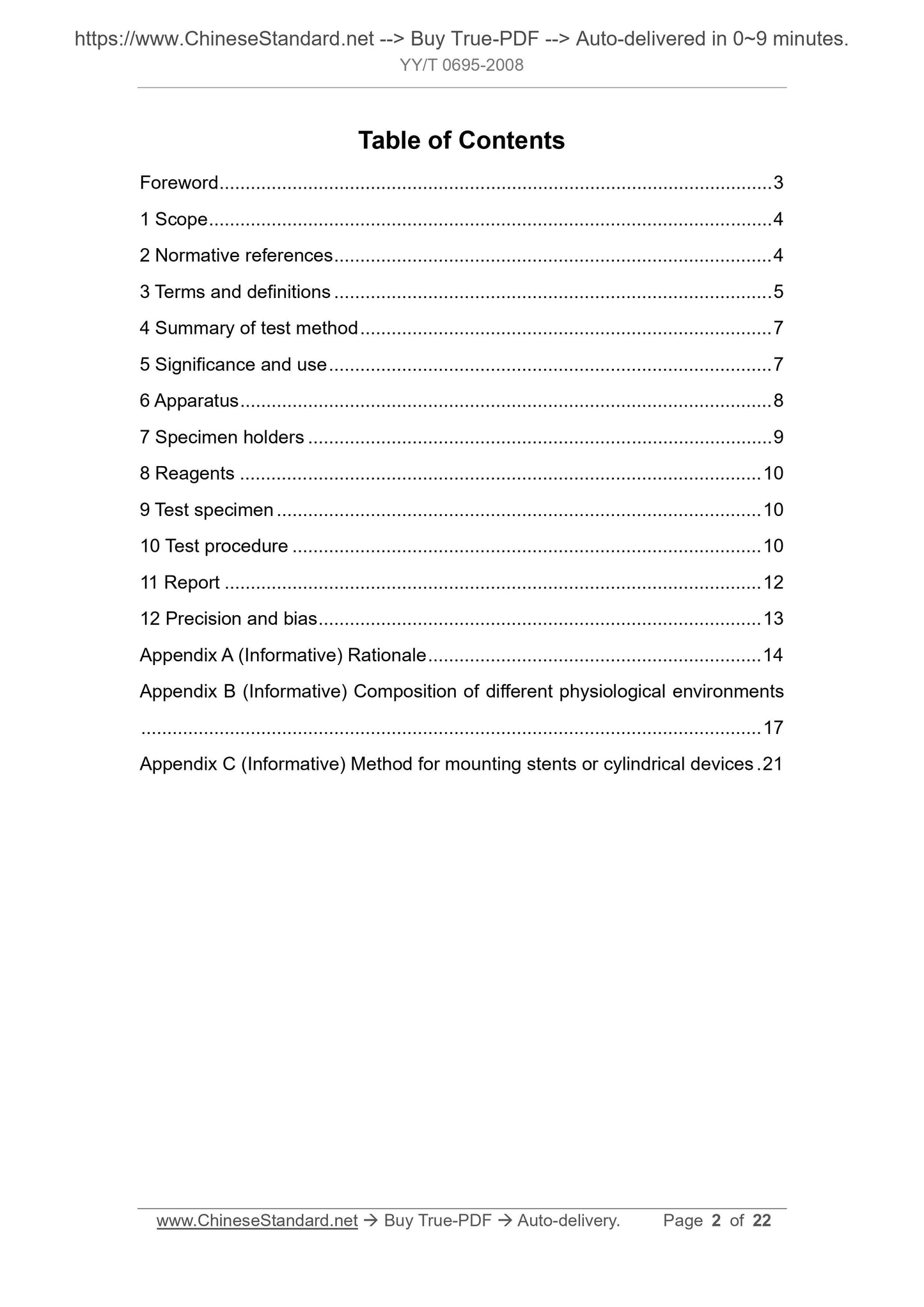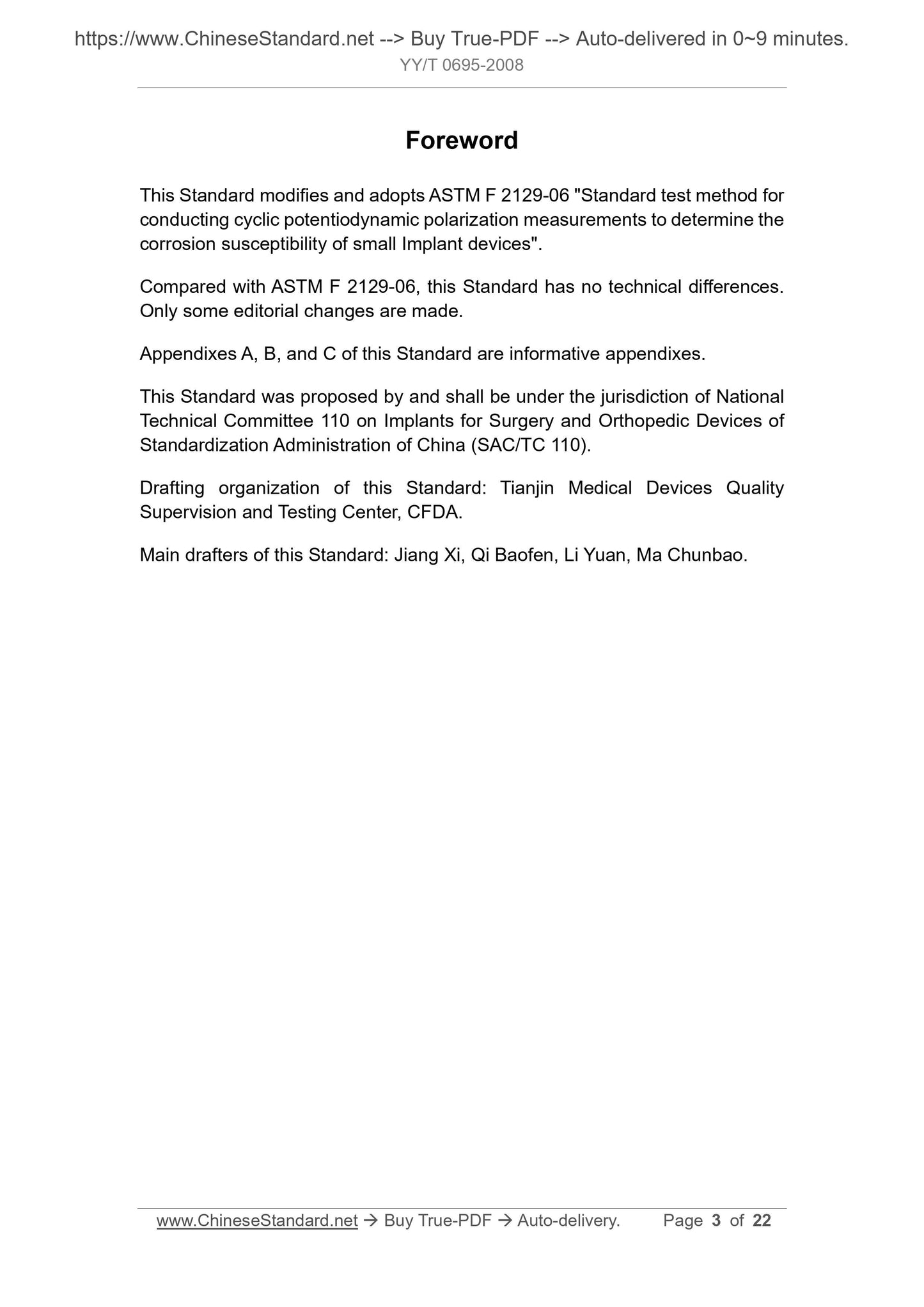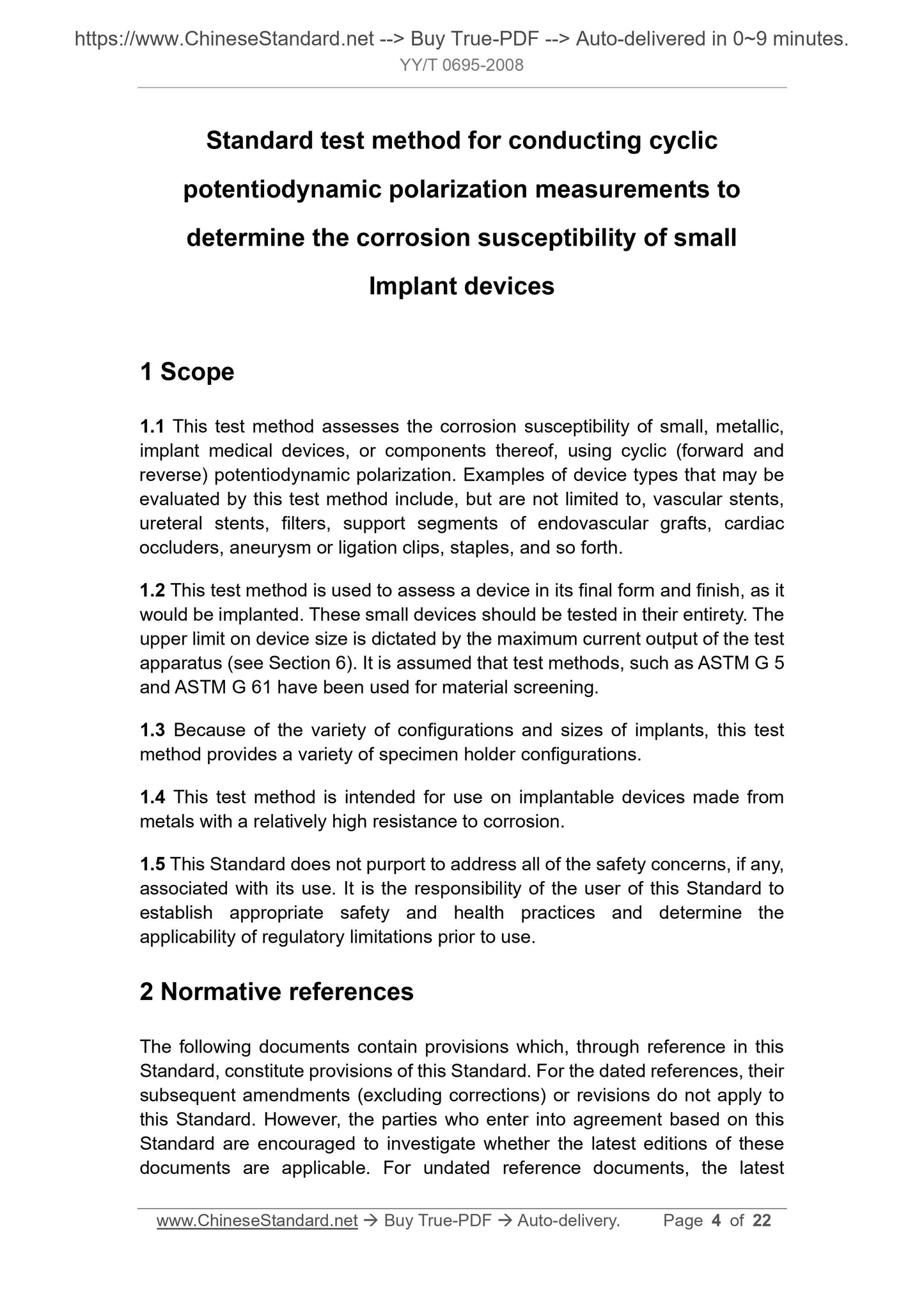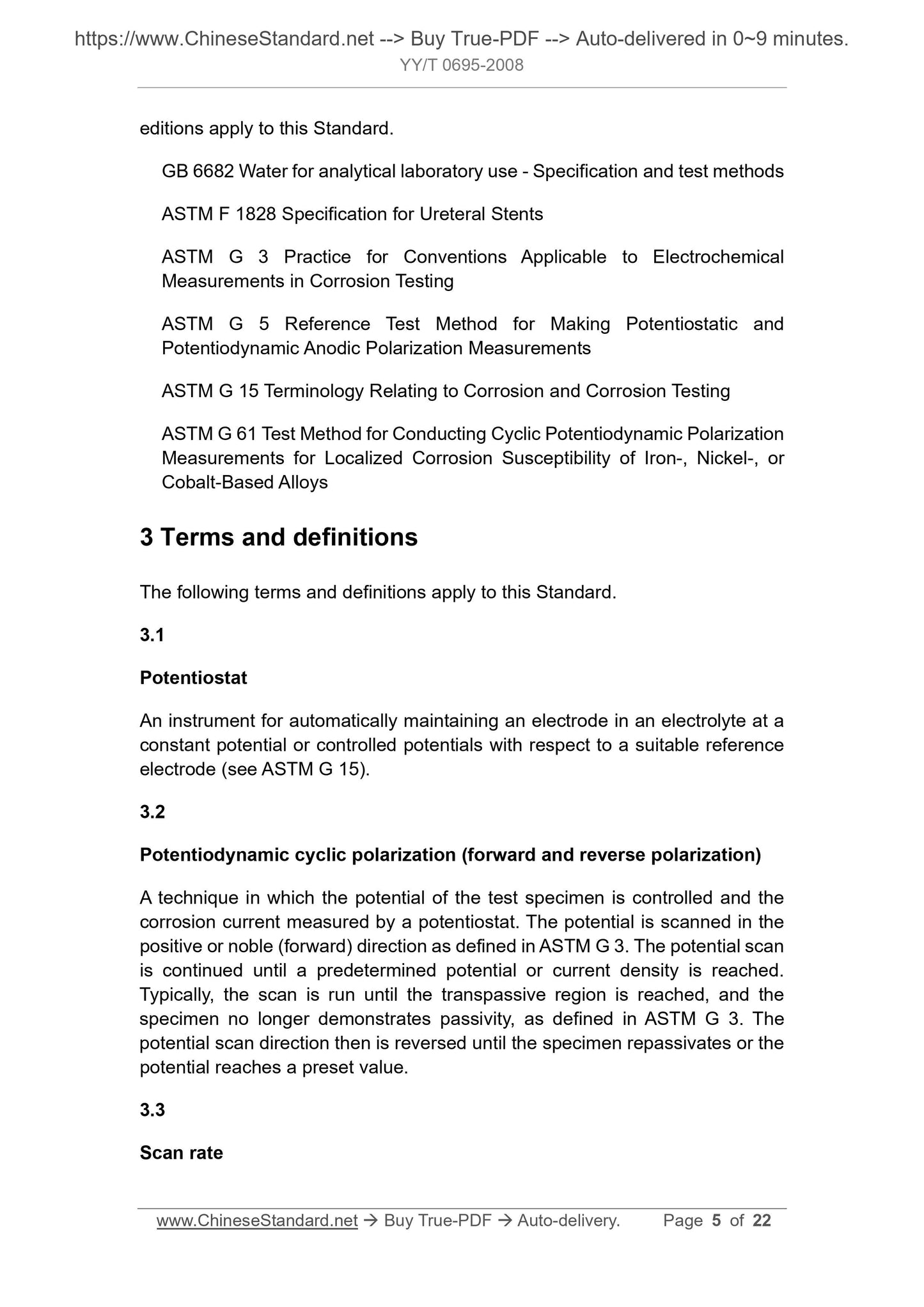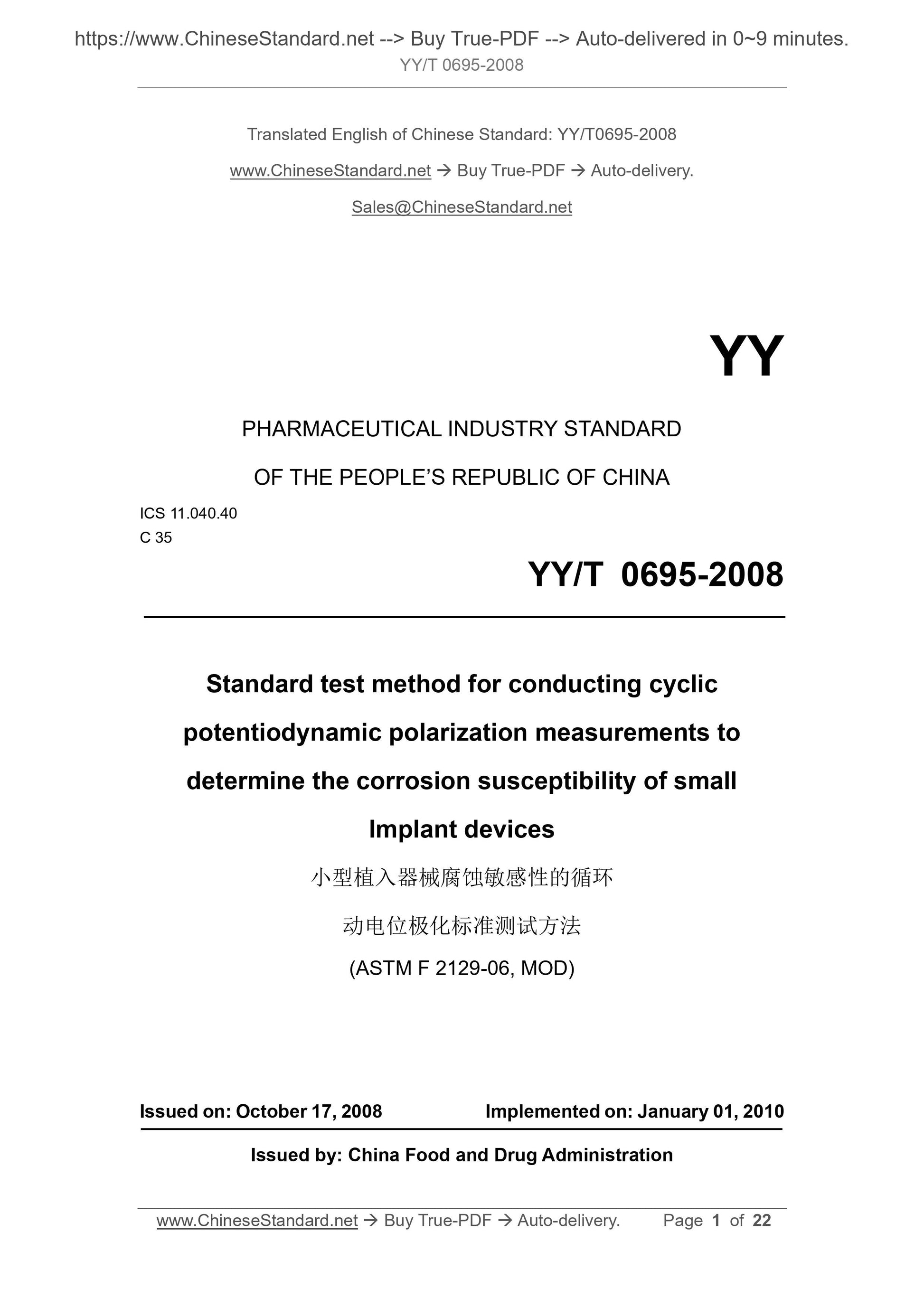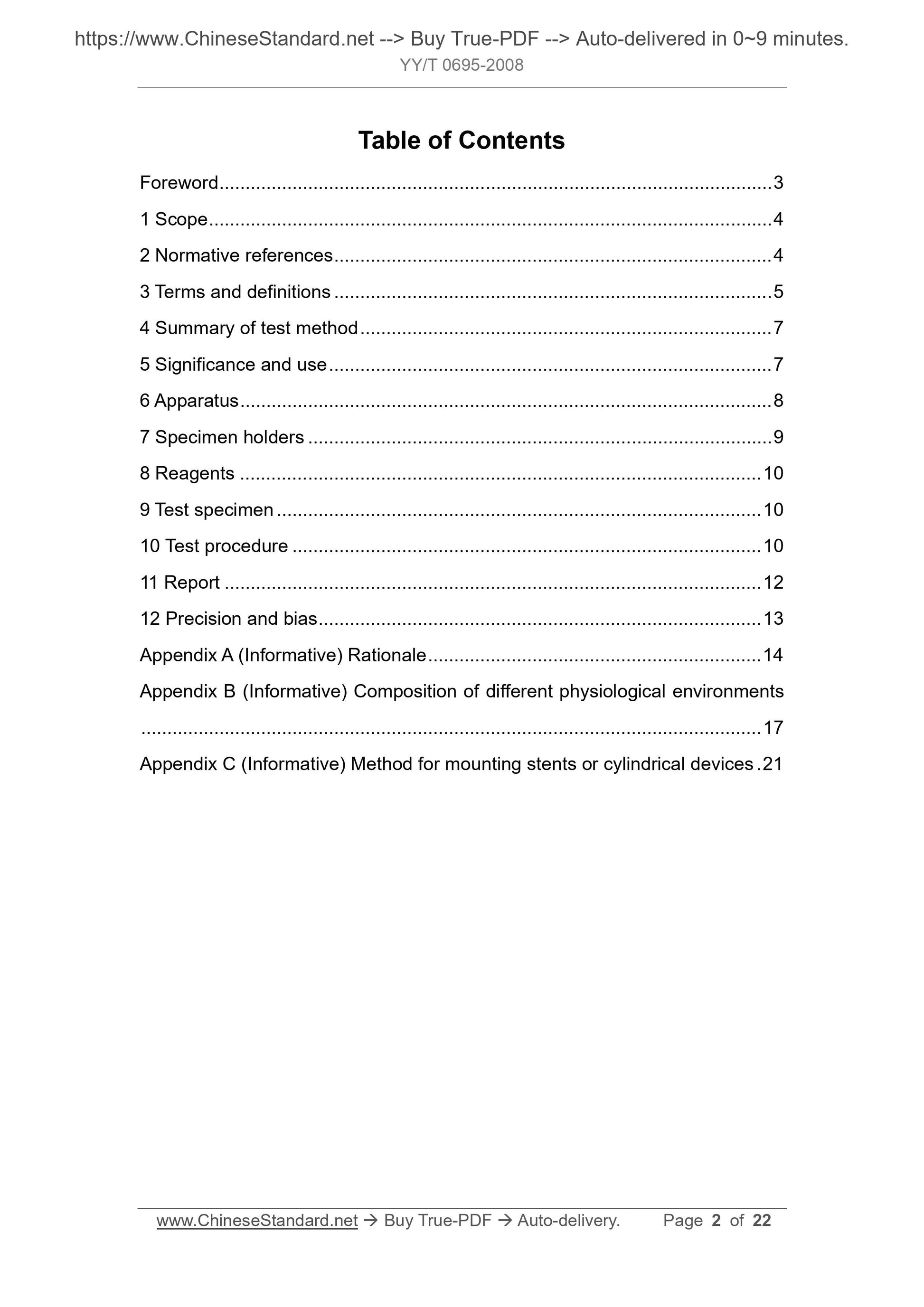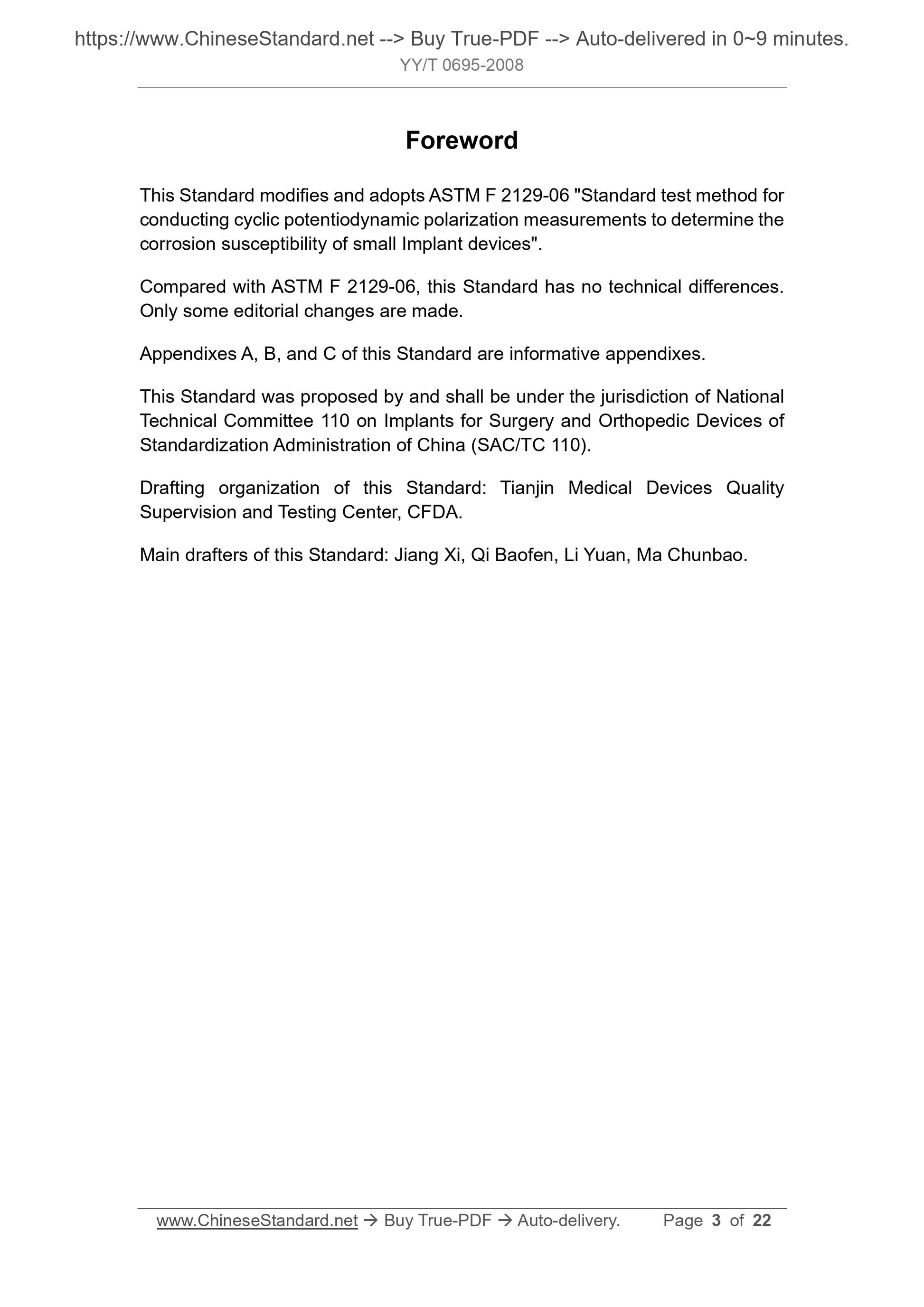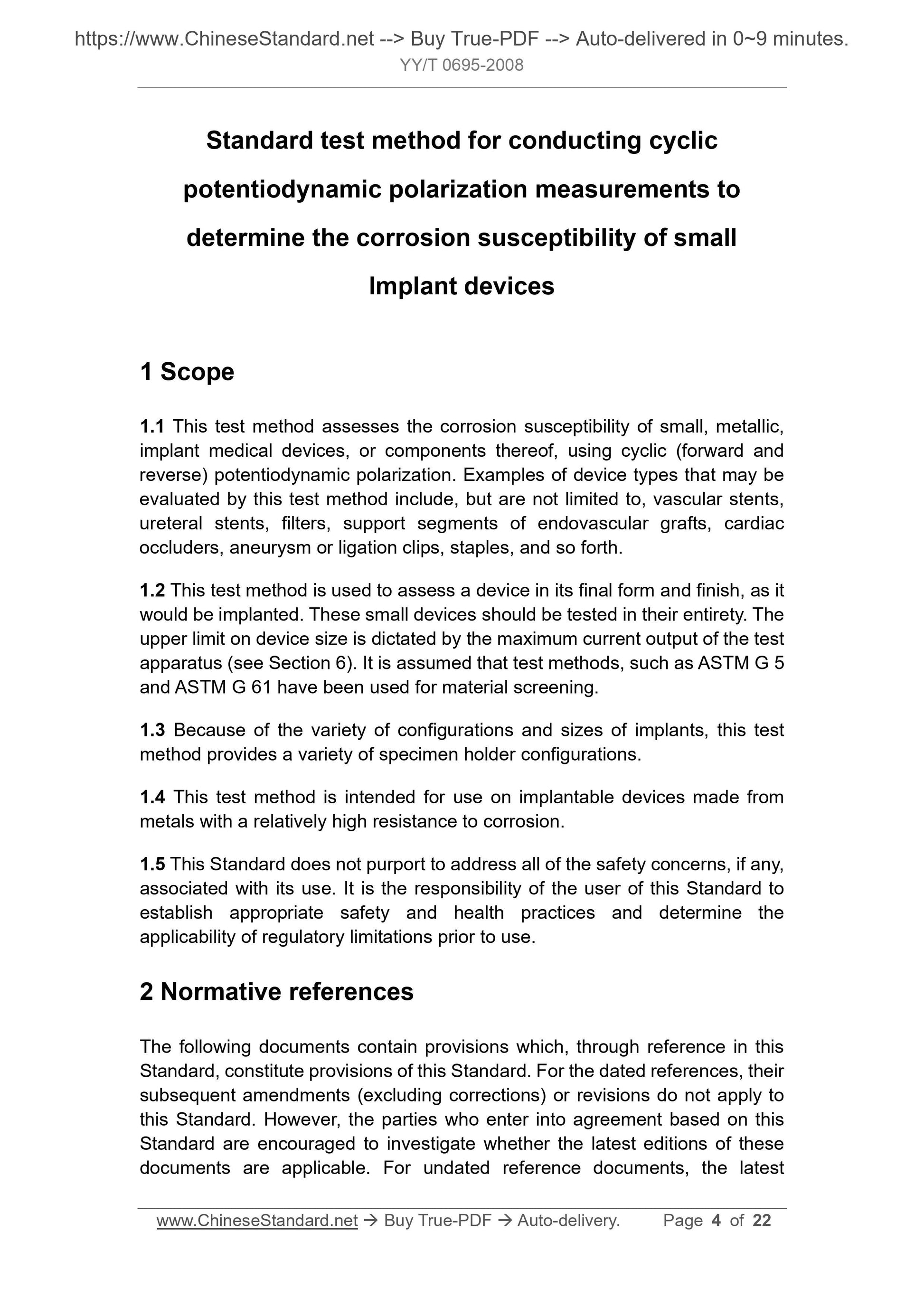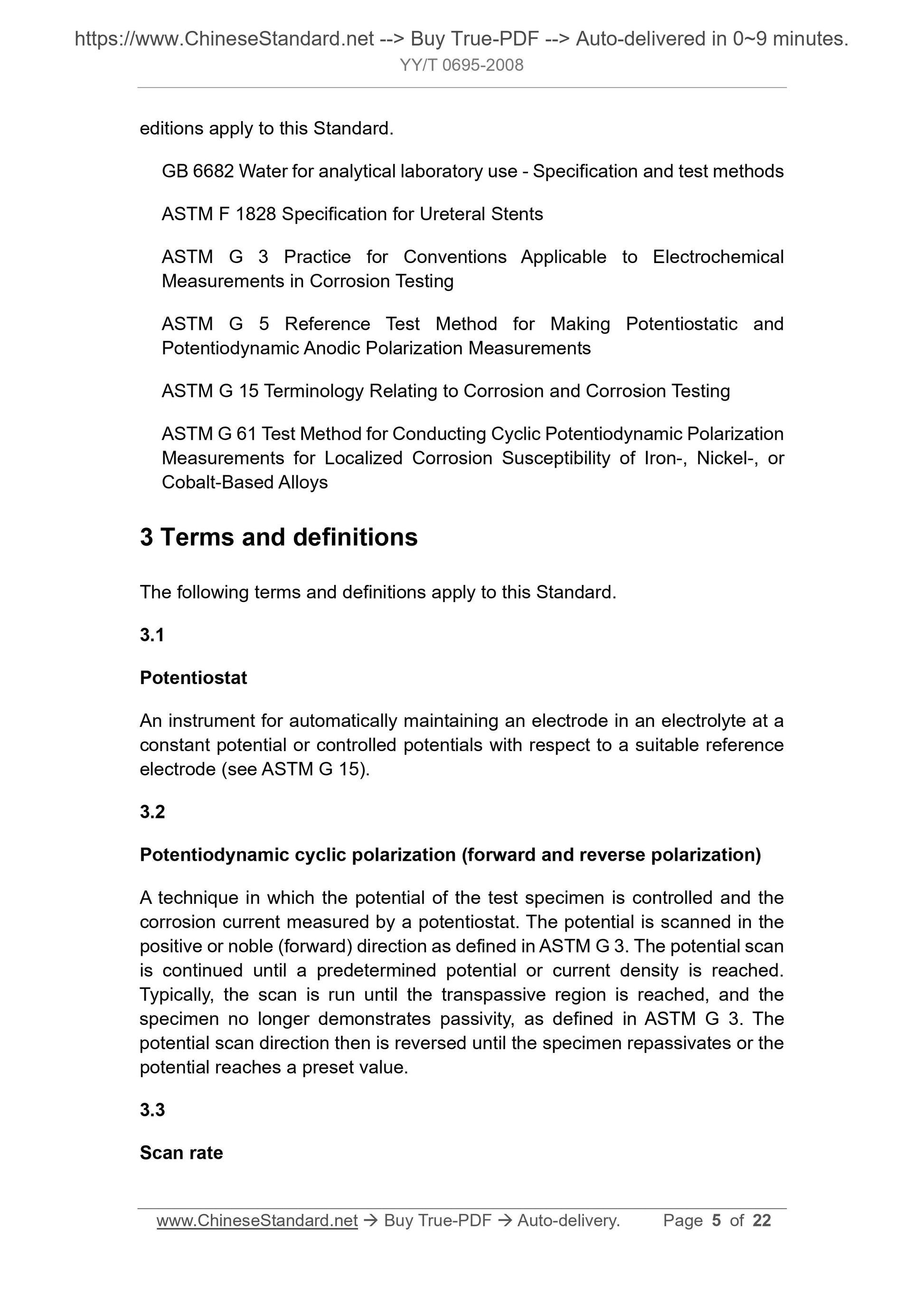1
/
of
5
PayPal, credit cards. Download editable-PDF and invoice in 1 second!
YY/T 0695-2008 English PDF (YYT0695-2008)
YY/T 0695-2008 English PDF (YYT0695-2008)
Regular price
$215.00 USD
Regular price
Sale price
$215.00 USD
Unit price
/
per
Shipping calculated at checkout.
Couldn't load pickup availability
Delivery: 3 seconds. Download true-PDF + Invoice.
Get QUOTATION in 1-minute: Click YY/T 0695-2008
Historical versions: YY/T 0695-2008
Preview True-PDF (Reload/Scroll if blank)
YY/T 0695-2008: Standard test method for conducting cyclic potentiodynamic polarization measurements to determine the corrosion susceptibility of small lmplant devices
YY/T 0695-2008
YY
PHARMACEUTICAL INDUSTRY STANDARD
OF THE PEOPLE’S REPUBLIC OF CHINA
ICS 11.040.40
C 35
Standard test method for conducting cyclic
potentiodynamic polarization measurements to
determine the corrosion susceptibility of small
Implant devices
(ASTM F 2129-06, MOD)
ISSUED ON: OCTOBER 17, 2008
IMPLEMENTED ON: JANUARY 01, 2010
Issued by: China Food and Drug Administration
Table of Contents
Foreword ... 3
1 Scope ... 4
2 Normative references ... 4
3 Terms and definitions ... 5
4 Summary of test method ... 7
5 Significance and use ... 7
6 Apparatus ... 8
7 Specimen holders ... 9
8 Reagents ... 10
9 Test specimen ... 10
10 Test procedure ... 10
11 Report ... 12
12 Precision and bias ... 13
Appendix A (Informative) Rationale ... 14
Appendix B (Informative) Composition of different physiological environments
... 17
Appendix C (Informative) Method for mounting stents or cylindrical devices . 21
Foreword
This Standard modifies and adopts ASTM F 2129-06 "Standard test method for
conducting cyclic potentiodynamic polarization measurements to determine the
corrosion susceptibility of small Implant devices".
Compared with ASTM F 2129-06, this Standard has no technical differences.
Only some editorial changes are made.
Appendixes A, B, and C of this Standard are informative appendixes.
This Standard was proposed by and shall be under the jurisdiction of National
Technical Committee 110 on Implants for Surgery and Orthopedic Devices of
Standardization Administration of China (SAC/TC 110).
Drafting organization of this Standard: Tianjin Medical Devices Quality
Supervision and Testing Center, CFDA.
Main drafters of this Standard: Jiang Xi, Qi Baofen, Li Yuan, Ma Chunbao.
Standard test method for conducting cyclic
potentiodynamic polarization measurements to
determine the corrosion susceptibility of small
Implant devices
1 Scope
1.1 This test method assesses the corrosion susceptibility of small, metallic,
implant medical devices, or components thereof, using cyclic (forward and
reverse) potentiodynamic polarization. Examples of device types that may be
evaluated by this test method include, but are not limited to, vascular stents,
ureteral stents, filters, support segments of endovascular grafts, cardiac
occluders, aneurysm or ligation clips, staples, and so forth.
1.2 This test method is used to assess a device in its final form and finish, as it
would be implanted. These small devices should be tested in their entirety. The
upper limit on device size is dictated by the maximum current output of the test
apparatus (see Section 6). It is assumed that test methods, such as ASTM G 5
and ASTM G 61 have been used for material screening.
1.3 Because of the variety of configurations and sizes of implants, this test
method provides a variety of specimen holder configurations.
1.4 This test method is intended for use on implantable devices made from
metals with a relatively high resistance to corrosion.
1.5 This Standard does not purport to address all of the safety concerns, if any,
associated with its use. It is the responsibility of the user of this Standard to
establish appropriate safety and health practices and determine the
applicability of regulatory limitations prior to use.
2 Normative references
The following documents contain provisions which, through reference in this
Standard, constitute provisions of this Standard. For the dated references, their
subsequent amendments (excluding corrections) or revisions do not apply to
this Standard. However, the parties who enter into agreement based on this
Standard are encouraged to investigate whether the latest editions of these
documents are applicable. For undated reference documents, the latest
editions apply to this Standard.
GB 6682 Water for analytical laboratory use - Specification and test methods
ASTM F 1828 Specification for Ureteral Stents
ASTM G 3 Practice for Conventions Applicable to Electrochemical
Measurements in Corrosion Testing
ASTM G 5 Reference Test Method for Making Potentiostatic and
Potentiodynamic Anodic Polarization Measurements
ASTM G 15 Terminology Relating to Corrosion and Corrosion Testing
ASTM G 61 Test Method for Conducting Cyclic Potentiodynamic Polarization
Measurements for Localized Corrosion Susceptibility of Iron-, Nickel-, or
Cobalt-Based Alloys
3 Terms and definitions
The following terms and definitions apply to this Standard.
3.1
Potentiostat
An instrument for automatically maintaining an electrode in an electrolyte at a
constant potential or controlled potentials with respect to a suitable reference
electrode (see ASTM G 15).
3.2
Potentiodynamic cyclic polarization (forward and reverse polarization)
A technique in which the potential of the test specimen is controlled and the
corrosion current measured by a potentiostat. The potential is scanned in the
positive or noble (forward) direction as defined in ASTM G 3. The potential scan
is continued until a predetermined potential or current density is reached.
Typically, the scan is run until the transpassive region is reached, and the
specimen no longer demonstrates passivity, as defined in ASTM G 3. The
potential scan direction then is reversed until the specimen repassivates or the
potential reaches a preset value.
3.3
Scan rate
Get QUOTATION in 1-minute: Click YY/T 0695-2008
Historical versions: YY/T 0695-2008
Preview True-PDF (Reload/Scroll if blank)
YY/T 0695-2008: Standard test method for conducting cyclic potentiodynamic polarization measurements to determine the corrosion susceptibility of small lmplant devices
YY/T 0695-2008
YY
PHARMACEUTICAL INDUSTRY STANDARD
OF THE PEOPLE’S REPUBLIC OF CHINA
ICS 11.040.40
C 35
Standard test method for conducting cyclic
potentiodynamic polarization measurements to
determine the corrosion susceptibility of small
Implant devices
(ASTM F 2129-06, MOD)
ISSUED ON: OCTOBER 17, 2008
IMPLEMENTED ON: JANUARY 01, 2010
Issued by: China Food and Drug Administration
Table of Contents
Foreword ... 3
1 Scope ... 4
2 Normative references ... 4
3 Terms and definitions ... 5
4 Summary of test method ... 7
5 Significance and use ... 7
6 Apparatus ... 8
7 Specimen holders ... 9
8 Reagents ... 10
9 Test specimen ... 10
10 Test procedure ... 10
11 Report ... 12
12 Precision and bias ... 13
Appendix A (Informative) Rationale ... 14
Appendix B (Informative) Composition of different physiological environments
... 17
Appendix C (Informative) Method for mounting stents or cylindrical devices . 21
Foreword
This Standard modifies and adopts ASTM F 2129-06 "Standard test method for
conducting cyclic potentiodynamic polarization measurements to determine the
corrosion susceptibility of small Implant devices".
Compared with ASTM F 2129-06, this Standard has no technical differences.
Only some editorial changes are made.
Appendixes A, B, and C of this Standard are informative appendixes.
This Standard was proposed by and shall be under the jurisdiction of National
Technical Committee 110 on Implants for Surgery and Orthopedic Devices of
Standardization Administration of China (SAC/TC 110).
Drafting organization of this Standard: Tianjin Medical Devices Quality
Supervision and Testing Center, CFDA.
Main drafters of this Standard: Jiang Xi, Qi Baofen, Li Yuan, Ma Chunbao.
Standard test method for conducting cyclic
potentiodynamic polarization measurements to
determine the corrosion susceptibility of small
Implant devices
1 Scope
1.1 This test method assesses the corrosion susceptibility of small, metallic,
implant medical devices, or components thereof, using cyclic (forward and
reverse) potentiodynamic polarization. Examples of device types that may be
evaluated by this test method include, but are not limited to, vascular stents,
ureteral stents, filters, support segments of endovascular grafts, cardiac
occluders, aneurysm or ligation clips, staples, and so forth.
1.2 This test method is used to assess a device in its final form and finish, as it
would be implanted. These small devices should be tested in their entirety. The
upper limit on device size is dictated by the maximum current output of the test
apparatus (see Section 6). It is assumed that test methods, such as ASTM G 5
and ASTM G 61 have been used for material screening.
1.3 Because of the variety of configurations and sizes of implants, this test
method provides a variety of specimen holder configurations.
1.4 This test method is intended for use on implantable devices made from
metals with a relatively high resistance to corrosion.
1.5 This Standard does not purport to address all of the safety concerns, if any,
associated with its use. It is the responsibility of the user of this Standard to
establish appropriate safety and health practices and determine the
applicability of regulatory limitations prior to use.
2 Normative references
The following documents contain provisions which, through reference in this
Standard, constitute provisions of this Standard. For the dated references, their
subsequent amendments (excluding corrections) or revisions do not apply to
this Standard. However, the parties who enter into agreement based on this
Standard are encouraged to investigate whether the latest editions of these
documents are applicable. For undated reference documents, the latest
editions apply to this Standard.
GB 6682 Water for analytical laboratory use - Specification and test methods
ASTM F 1828 Specification for Ureteral Stents
ASTM G 3 Practice for Conventions Applicable to Electrochemical
Measurements in Corrosion Testing
ASTM G 5 Reference Test Method for Making Potentiostatic and
Potentiodynamic Anodic Polarization Measurements
ASTM G 15 Terminology Relating to Corrosion and Corrosion Testing
ASTM G 61 Test Method for Conducting Cyclic Potentiodynamic Polarization
Measurements for Localized Corrosion Susceptibility of Iron-, Nickel-, or
Cobalt-Based Alloys
3 Terms and definitions
The following terms and definitions apply to this Standard.
3.1
Potentiostat
An instrument for automatically maintaining an electrode in an electrolyte at a
constant potential or controlled potentials with respect to a suitable reference
electrode (see ASTM G 15).
3.2
Potentiodynamic cyclic polarization (forward and reverse polarization)
A technique in which the potential of the test specimen is controlled and the
corrosion current measured by a potentiostat. The potential is scanned in the
positive or noble (forward) direction as defined in ASTM G 3. The potential scan
is continued until a predetermined potential or current density is reached.
Typically, the scan is run until the transpassive region is reached, and the
specimen no longer demonstrates passivity, as defined in ASTM G 3. The
potential scan direction then is reversed until the specimen repassivates or the
potential reaches a preset value.
3.3
Scan rate
Share
